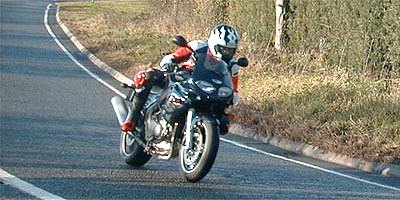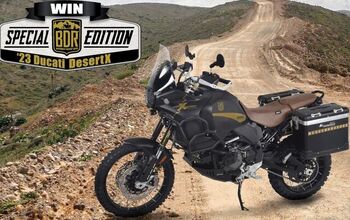2000 Triumph Sprint RS - Motorcycle.com
Lincolnshire, England, March 9, 2000 -- Many pundits have been citing the forthcoming TT600 as Triumph's most important bike to date. To me, as a thirty-something biker, this is missing a critical point. Yes, catching a younger and more sporting audience is crucial to Triumph's long term strategy, but just as important is looking after their core following and attracting more into that fold.
Triumph sells on tradition, not in the same way as Harley, who consistently ape the days of yore with even their most up-to-date bikes, but by selling modern bikes with an old name, a name that is carved into the psyche of those 40-year-old bikers, be they "born-agains" or not.
Triumph knows that this name must be backed by the qualities that this market demographic seeks in a motorcycle: It has to look good, it has to be easy to ride, it has to be fast -- but not too fast -- and it has to be dependable.
The Sprint RS has all these qualities and just enough ingredients from the sporting side to appeal to riders who are ever-more seduced by the sport bike groove. This bike is just as important, if not more so, to Triumph's success in the salesrooms as any 600 Supersport bike ever will be. It needs to do it in the same way as the VFR has underpinned Honda's reputation and image even while the CBR600 ran off with the best selling bike honors the world over. After collecting the bike from Triumph's factory in Hinckley in central England, the first thing I noticed was the build quality. This has been a constant issue at Triumph as they endeavour to extract ever higher standards from their suppliers and their own assembly lines. The RS looks right, the body panels fit together nicely and the paint is thick and resilient.
The worst winter salt and grime failed to dull the shine, even after two weeks of nasty weather and a night in a damp garage. The bike looks great, it looks sporty and I loved the blue paintwork on my test machine. The look was rich, quality -- you know, like on that VFR we already mentioned.
"Triumph won't actually admit it but the Sprint line, including the full-faired ST, is built to steal the ground from the VFR."
OK, time to expose the truth. There's no doubt that bikes like Honda's brilliant VFR are within the crosshairs of this bike. Triumph won't actually admit it but the Sprint line, including the full-faired ST, is built to steal the ground from the VFR. It even looks a little like it. Triumph is clearly aiming to match Honda's reputation for reliability and so far I haven't experienced evidence of long-term reliability problems on the latest version of Triumph's triple-cylinder motor. The evidence is there to see regarding build quality so the next question is what is it like to ride. My best answer to that question is a huge smile.
Riding back from Hinckley to my base in Lincolnshire is a journey that can be accomplished with two distinct routes. One involves 125 miles of crowded British motorway (American readers will call it a freeway), governed by a 70 mph speed limit and bereft of all but the gentlest of corners. The other is 125 miles of flat out "A" roads that start off arrow straight.
Many British trunk roads still follow the Roman roads built 2000 years ago) but finish in true Lincolnshire style, empty, curvy and exciting. So you can guess which route I took, huh? Right! The RS is no motorway bike. It's surprisingly efficient half-fairing and relaxed riding position makes motorway riding a "doddle," but the engine and chassis combine to cry out for roads that have a higher fun factor. The first stretch allowed me to test the riding position, which, despite being a lanky six-footer, was accommodating. The bars are set high enough to retain a posture that won't send your back into spasms, yet is "racy" enough to allow a sporting riding stance when the bends begin to flow. The saddle is firm but didn't cause any discomfort over the 125 mile non-stop journey.
The engine is a peach. And this is the part that brings me back to my opening paragraph. Most modern riders are too old, or too inexperienced, to use a real race-replica-type bike to its full potential. What they really want, or need, is a bike with an engine that produces plenty of power at all revs. The lightweight, liquid-cooled, fuel-injected, 955cc three-cylinder motor is based on the Daytona 955i's unit, but retuned to produce a claimed 108bhp at 9,200 rpm and 72 lbs/ft at 6,200 rpm. Both were at the crank, with a huge spread of torque across the rev range.
This is the bike's ace card -- a powerful yet extremely flexible engine. What's more is that it's a motor that helps to produce that all-too-elusive element that's so important in a motorcycle -- character. The engine makes you play games, and you'll find yourself deliberately letting the revs drop just so you can ride the wave of power from almost nothing, feeling the fat torque bulging through the middle range and building to an impressive rush of outright power as the redline draws near. This is a rider's bike and, in my opinion, has more character than the Honda VFR800.
The RS has its three-cylinder motor wrapped in a black-painted aluminium beam perimeter frame, abandoning the tubes that cradle the engine on the 955i Daytona. This frame combines with the suspension, Showa front and rear, to produce a ride that is firm and dependable. The longish wheelbase helps with a stable feeling but on-the-edge canyon carvers might dislike the slightly slower steering response this produces. To be honest, while I am a committed fan of the mega-sports bike, I prefer a bike like this on the road.
"Race-rep bikes are great on a track but who needs that razor sharp stuff when rising on cold English Tarmac?"
The RS did everything I asked of it, although I'll freely admit I am sensible enough not to ask too much when riding a bike on a road with street furniture, cars and trees awaiting my first serious mistake! The brakes? On the VFR they are excellent but they've been linked to help the inexperienced stop without tying the bike in knots, or more likely, losing grip at the front due to manhandling the lever in emergencies. I'd rather Honda provide a switch so the more experienced rider could turn off the damn thing. If I want my front brake then I'll pull the lever. If I want my rear brake I'll press the pedal.
The last thing I want when gently stroking the rear brake pedal in foul conditions is for some monkey-machine actuating a front disc. For me, at least, that stuff belongs in soft-seated cars, not on motorcycles.
The Triumph's braking doesn't have such intrusions. But it does have a pair of extremely powerful front discs, gripped by four piston callipers and loads of feel -- just as important in my book as LBS technology. The rear brake is just as powerful and has loads of feel too, a welcome change from some of the on-off rear brakes fitted to the early Triumphs and the deadwood one's fitted to some more recent models.
Like any bike, their are areas where you can pick faults, but with most modern motorcycles the evaluator must be really picky to name them. The rather loud start up of the fuel injection system is about the only "fault" I could mention on this bike, but it quietens down once the engine is primed and running.
The engine is still a little noisy at tickover, typically Triumph but a great improvement on the diesel-like rattling of early Triumph Triples. That's it, the full niggle list. Just how short and insignificant is that list is a tribute to how good motorcycles are today. The RS is designed to be a multi-purpose all-rounder. For this role Triumph has equipped the bike with a flexible engine, a competent chassis, excellent brakes and a comfortable cockpit. They've also added an options package that includes hard luggage in case you want to exploit the bike's undoubted long-distance touring credentials. Triumph has worked hard on the bike, incorporating lessons learned on previous model ranges, and it's a mark of their success that in a few short years the new factory has come up with a line that can be counted as a serious contender to the Honda VFR800, a long-established, competent and very successful motorcycle. Only time will tell if the RS has the legs of the Honda, both in the reliability and sales stakes.
Specifications:
Manufacturer: Triumph
Model: 2000 Sprint RS
Engine: Liquid-cooled, DOHC, in-line 3-cylinder
Displacement: 955cc
Bore x stroke: 79 x 65 mm
Compression ratio: 11.2:1
Carburetion: Multipoint sequential electronic fuell-injection
Transmission: wet, multi-plate, 6-speed
Frame: Aluminium beam perimeter
Tire, front: 120/70 ZR 17
Tire, rear: 180/55 ZR 17
Suspension, front: 43mm cartridge forks with dual rate springs with
adjustable preload
Suspension, rear: Monoshock w adjustable preload and rebound damping
Brakes, front: Twin 320mm floating discs, 4 piston caliper
Brakes, rear: Single 255mm disc, 2 piston caliper
Rake/trail: 24.5°/89mm
Wheelbase: 1470mm (57.9in)
Seat Height: 805mm (31.7in)
Fuel capacity: 21L (5.6 US gal)
Weight, dry (claimed): 199kg (438lbs)
More by Glenn LeSanto, British Desk


































Comments
Join the conversation